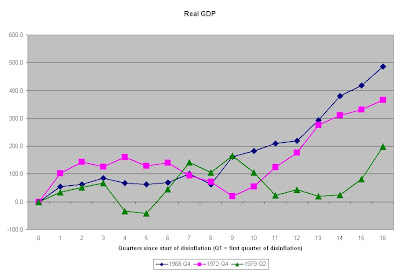
To generalize, you could say that in the 1969 disinflation the Fed abandoned its efforts after about four quarters, and in the 1973 disinflation the Fed gave up the ghost around quarter 8. In both cases, it gave up just around the time GDP began to flatten and unemployment began to rise sharply. As a result there was no significant drop in inflation; the disinflations failed.
By contrast, in the 1979 disinflation the Fed held tight for about 12 or 13 quarters. It tightened only when inflation was 4 percentage points below its 1979 peak. It held out through several quarters of flattening GDP and rising unemployment. As a result, this disinflation was successful.
Why did the Fed behave differently in 1979-82 than it did in the earlier disinflations? Lots of economists think it had something to do with economists' and policymakers' understanding of the economy, in particular what they thought was the magnitude of the tradeoff between inflation and unemployment, whether they thought inflation was a monetary or a cost-push phenomenon, what their estimate of the natural rate of unemployment was. A smaller number think it was politics: the Fed had a mandate to end inflation in 1979, but it lacked that mandate (and was under great pressure to help the economy avoid a serious recession) earlier. See here for an interesting exchange.
Me, I think it's the latter. AND I CAN PROVE IT! But I have to write the paper.














0 comments:
Post a Comment